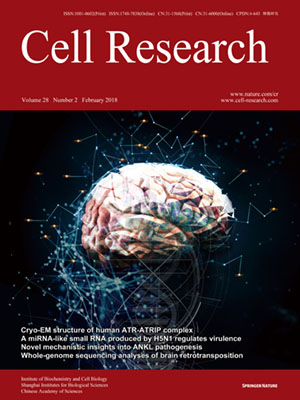
Volume 28, No 2, Feb 2018
ISSN: 1001-0602
EISSN: 1748-7838 2018
impact factor 17.848*
(Clarivate Analytics, 2019)
Volume 28 Issue 2, February 2018: 143-156
ORIGINAL ARTICLES
Cryo-EM structure of human ATR-ATRIP complex
Qinhui Rao1,2,3,*, Mengjie Liu1,2,3,*, Yuan Tian1,2,3, Zihan Wu1,2,3, Yuhan Hao1,2,3, Lei Song4, Zhaoyu Qin1, Chen Ding1,3, Hong-Wei Wang5, Jiawei Wang5, Yanhui Xu1,2,3,6
1Fudan University Shanghai Cancer Center, Institute of Biomedical Sciences, Shanghai Medical College of Fudan University, Shanghai 200032, China;
2Key Laboratory of Molecular Medicine, Ministry of Education, Department of Systems Biology for Medicine, School of Basic Medical Sciences, Shanghai Medical College of Fudan University, Shanghai 200032, China;
3State Key Laboratory of Genetic Engineering, Collaborative Innovation Center of Genetics and Development, School of Life Sciences, Fudan University, Shanghai 200433, China;
4State Key Laboratory of Proteomics, Beijing Proteome Research Center, Beijing Institute of Radiation Medicine; National Center for Protein Sciences (The PHOENIX center, Beijing), Beijing 102206, China;
5Ministry of Education Key Laboratory of Protein Sciences, Tsinghua-Peking Joint Center for Life Sciences, Beijing Advanced Innovation Center for Structural Biology, School of Life Sciences, Tsinghua University, Beijing 100084, China;
6CAS Center for Excellence in Molecular Cell Science, Chinese Academy of Sciences, Shanghai 200031, China
Correspondence: Yanhui Xu,E-mail: xuyh@fudan.edu.cn; Jiawei Wang,E-mail: jwwang@tsinghua.edu.cn; Hongwei Wang,(hongweiwang@tsinghua.edu.cn)
ATR (ataxia telangiectasia-mutated and Rad3-related) protein kinase and ATRIP (ATR-interacting protein) form a complex and play a critical role in response to replication stress and DNA damage. Here, we determined the cryo-electron microscopy (EM) structure of the human ATR-ATRIP complex at 4.7 Å resolution and built an atomic model of the C-terminal catalytic core of ATR (residues 1 521-2 644) at 3.9 Å resolution. The complex adopts a hollow “heart” shape, consisting of two ATR monomers in distinct conformations. The EM map for ATRIP reveals 14 HEAT repeats in an extended “S” shape. The conformational flexibility of ATR allows ATRIP to properly lock the N-termini of the two ATR monomers to favor ATR-ATRIP complex formation and functional diversity. The isolated “head-head” and “tail-tail” each adopts a pseudo 2-fold symmetry. The catalytic pockets face outward and substrate access is not restricted by inhibitory elements. Our studies provide a structural basis for understanding the assembly of the ATRATRIP complex and a framework for characterizing ATR-mediated DNA repair pathways.
10.1038/cr.2017.158
FULL TEXT | PDF
Browse 2472


